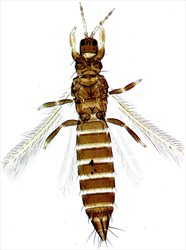
Female
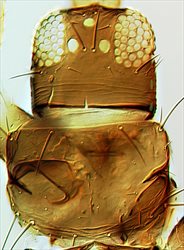
Head & pronotum
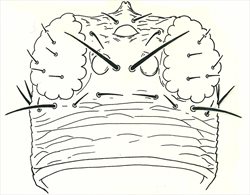
Head

Antenna

Antenna
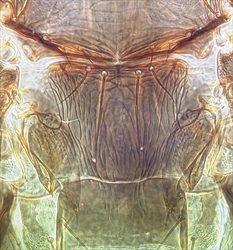
Meso & metanota
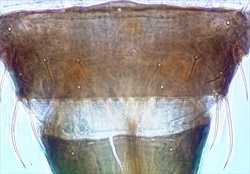
Female tergite VIII
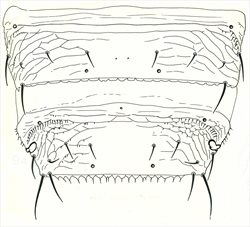
Female tergites VII-VIII
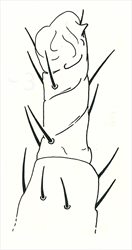
Fore tarsus
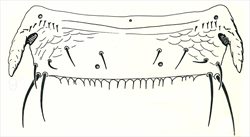
Male tergite VIII

Fore wing

Male sternites
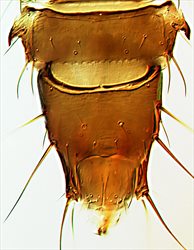
Male tergites VIII-IX
Both sexes fully winged. Female dark brown, tarsi and antennal segment III yellow; fore wing dark with base paler. Antennae 8-segmented; segments III–IV each with forked sense cone, VIII scarcely longer than VII. Head about as long as wide, not projecting in front of eyes; 3 pairs of ocellar setae present, pair III as long as inter-ocular distance, arising between posterior ocelli; postocular setae pair I absent, pair IV about 3 times as long as diameter of one hind ocellus. Pronotum with 5 pairs of major setae; anteromarginal setae shorter than anteroangulars; posterior margin without a pair of minor setae medially between posteromarginal submedian setae. Metanotum with median setae close to anterior margin, campaniform sensilla present. Fore wing with 2 complete rows of veinal setae. Fore tarsus with triangular tooth at apex of pulvillus. Abdominal tergites VI–VIII with pair of weakly developed ctenidia, on VIII anterolateral to spiracle; tergite VIII with posteromarginal comb of fine microtrichia that arise from triangular bases. Sternites III–VII without discal setae, VII with posteromarginal setal pair S1 arising well in front of margin.
Male similar to female but smaller with abdomen more slender; tergite VIII with irregular but complete posteromarginal comb, ctenidia on VIII arising on paired lateral projections anterior to the spiracles; sternites III–VII each with large transverse pore plate.
The European genus Kakothrips is closely related to Frankliniella, but the seven species all have a tooth on the fore tarsal pulvillus, and the S1 setae on sternite VII of females arise in front of the sternite margin. Specimens of K. pisivorus lack a pair of minor setae medially on the posterior margin of the pronotum (Mound et al., 1976; Marullo & Ravazzi, 2016), although these setae are inadvertently suggested as being present by zur Strassen (2003, Fig. 367: as K. robustus).
Known as the Pea Thrips, and feeding and breeding in flowers, although apparently pupating at soil level. This species is recorded from the flowers of many different species of Fabaceae, in genera such as Pisum, Lathyrus, Vicia, Lotus, and Phaseolus.
Recorded from England as far north as the Lake District, but has not been collected in either Scotland or Wales (Mound et al., 1976). Moreover, although included in the Irish checklist by O'Connor (2008), that record was based on an unsubstantiated report (Morison, 1957). In Europe it is widespread from northwest to southeast, and then onwards to Syria and Iran. Much European literature refers to the species under its junior synonym of K. robustus (Uzel) (Collins, 2010a).
THRIPIDAE - THRIPINAE
Kakothrips pisivorus (Westwood)
Thrips pisivorus Westwood, 1880: 206
Physopus robusta Uzel, 1895: 104
Collins DW (2010a) Thysanoptera of Great Britain: a revised and updated checklist. Zootaxa 2412: 21–41.
Marullo R & Ravazzi G (2016) The first micropterous species of the southern European genus Kakothrips (Thysanoptera: Thripidae). Zootaxa 4067 (4): 460–462.
Morison GD (1957) A review of British Glasshouse Thysanoptera. The Transactions of the Royal Entomological Society of London 109 (16): 467–534.
Mound LA, Morison GD, Pitkin BR & Palmer JM (1976) Thysanoptera. Handbooks for the Identification of British Insects 1 (11): 1–79.
O’Connor JP (2008) A review of the Irish thrips (Thysanoptera). Irish Naturalists’ Journal 29: 20–24.
zur Strassen R (2003) Die terebranten Thysanopteren Europas und des Mittelmeer-Gebietes. Die Tierwelt Deutschlands 74: 1–271.